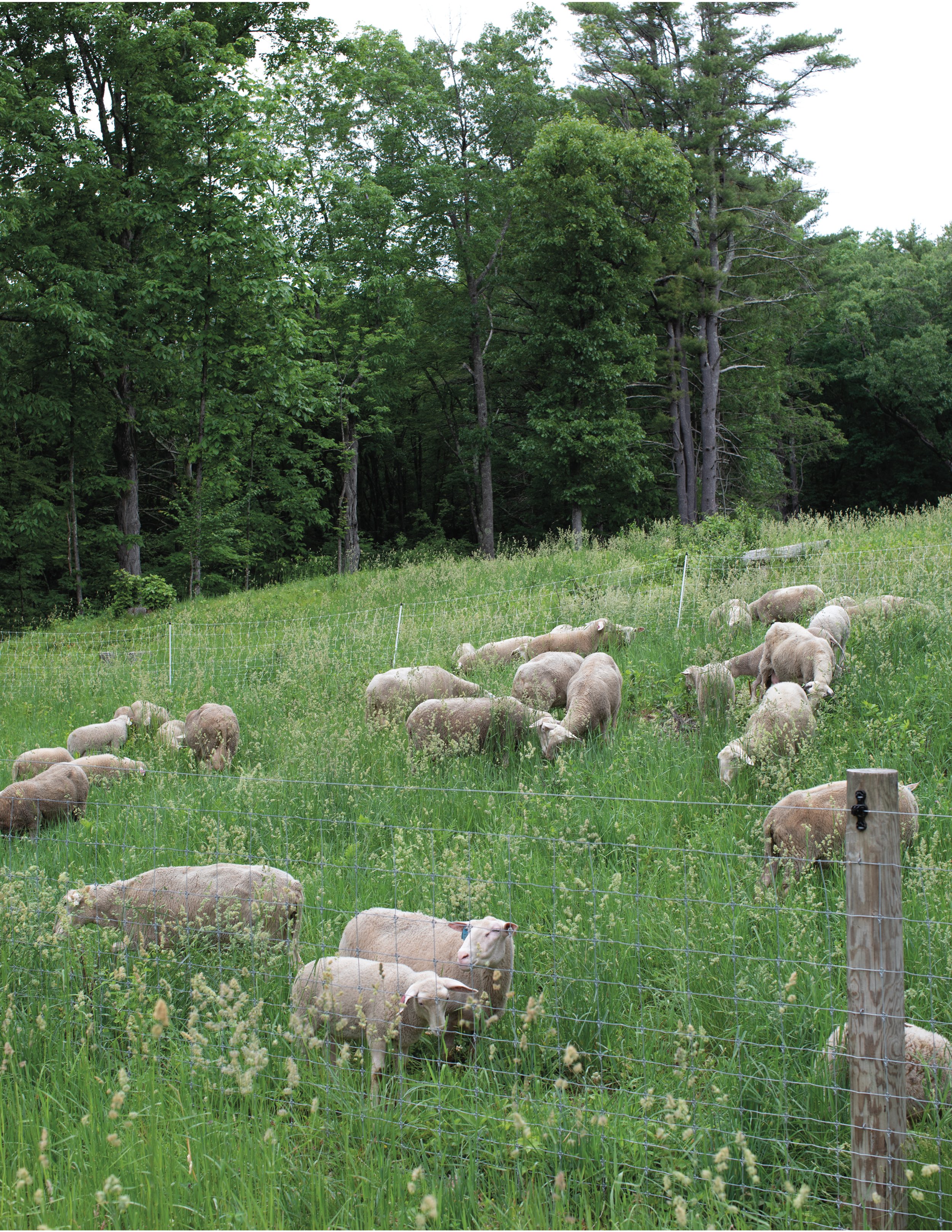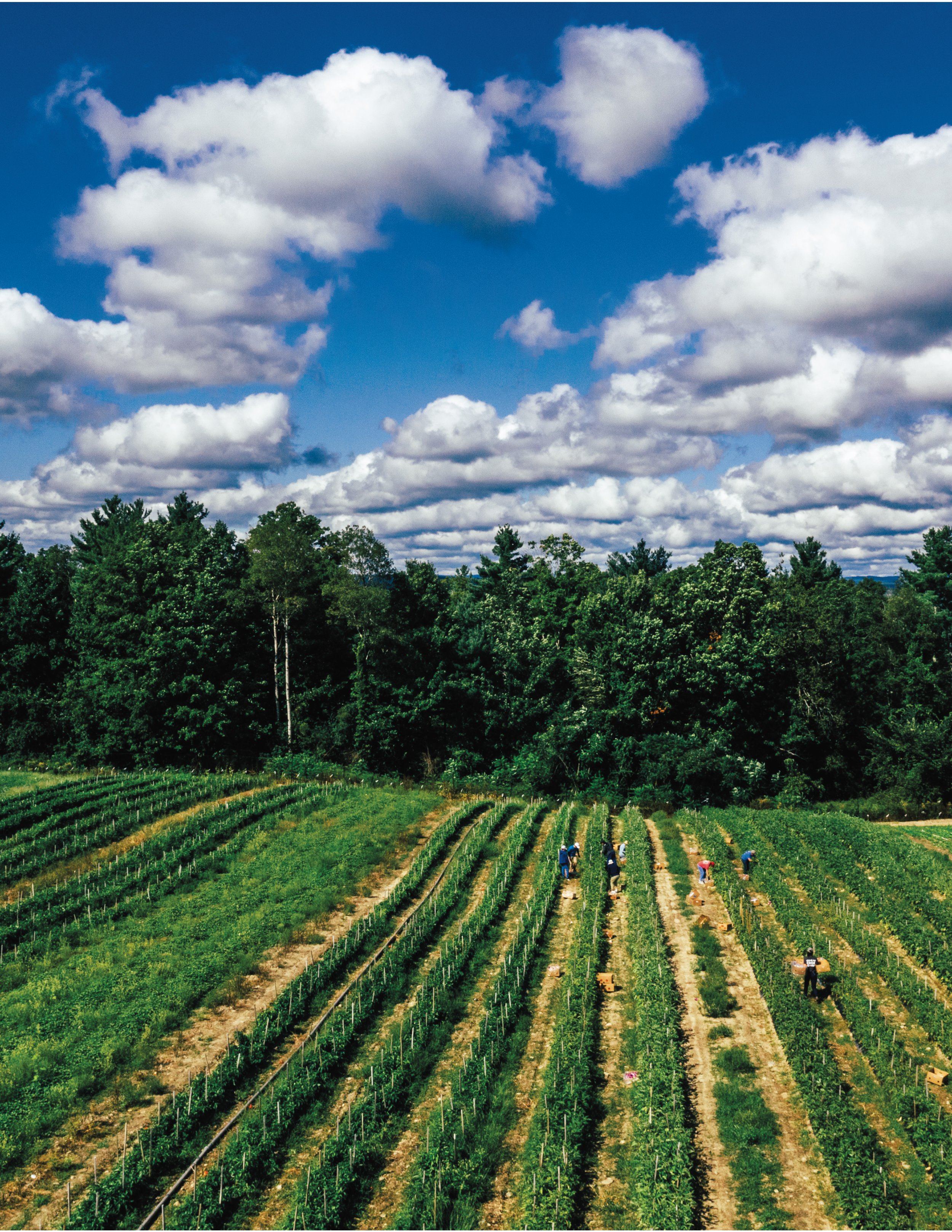Finding That “Forever Farm”
Photos by Michael Piazza
On a cloudless spring day, Josh Atherton stands viewing his fields. The popup greenhouse is full of seedlings—tomatoes, lettuces, eggplant and more. The fields are furrowed, the drip tape ready, the farm equipment nearby. It’s the start of a new season, one he hopes will be profitable for Utopia Farm and his farmstand in Manchester-by-the-Sea.
Atherton has a strong connection to this plot of land surrounded by suburban houses, having worked on it or nearby since he was a teenager. He doesn’t own these acres; instead, he leases them. But someday, Atherton hopes to get his “forever farm” with permanent greenhouses and a barn as well as housing.
For Cara Germain and Michael Zueger, a new lease on Worcester County farmland that includes two heated greenhouses, a barn and an orchard makes sense for now. They have a growing CSA and client base at the Sturbridge farmers market for their organically raised vegetables. As well as the protected status of the farmland, the house they rent on the property was an important factor. “It’s crucial,” she says, “to be on the land because you’re out there every day working.” In the future, she says, owning a farm is a goal, but for now “we have everything we need.”
In New England, these sagas of searching for a “forever farm” are typical. Land—or rather the scarcity of affordable land—has been at the problematic center of sustainable farming in the Northeast for decades. As consumers shop for beautifully presented vegetables, eggs and meat at farm stands or farmers markets, they rarely think about where those farmers grow their crops, where they live and what lies in their futures.
Consumers gained a whole new perspective on eating locally when the pandemic hit in 2020 and grocery shelves emptied. “Farms are local food security,” Jamie Pottern of American Farmland Trust (AFT) says succinctly. The trust’s comprehensive 2020 report on the state of New England farmland outlines encroachment on agricultural land, both by urban development and by what’s called low density residential (where housing fragments farm acreage, and eventually erodes agricultural viability). AFT reported that between 2001 and 2016, more than 105,000 acres of agricultural land was lost or severely impacted in New England, and while the region has some of the nation’s strongest policies and programs to restrict development, only 12.5% of New England agricultural land is permanently protected, says Pottern. A just-released study from AFT predicts that without additional policy efforts to protect land, Massachusetts alone could lose over 73,000 acres of its farmland by 2040 to development.
Nonetheless, several nonprofits are working to train farmers and get them onto land, whether through ownership or workable leases. The need is urgent, say officials from organizations such as New Entry Sustainable Farming Project, Land for Good and Essex County Greenbelt, for both consumers and the future of land use. Farmers across the nation are getting older; a 2017 USDA report listed New England farmers’ average age as 61. Coupled with that, fewer family members are stepping up to take over farming and high land prices often convince heirs to sell.
There is no lack of aspiring young farmers, but the desire alone is not enough these days; transforming the dream into reality takes a lot of business savvy. New Entry, located in North Beverly, trains farmers not just in how to farm but in farming’s finances. Participants, who ideally have some agricultural experience, start out by writing a detailed business plan before they farm small plots of land. Where they might farm after three years in the New Entry incubator program is integral. “We really start the land conversation the first year,” says Jennifer Hashley, program director, adding “you can’t start in Year 3.”
The conversations aren’t simple. Though finding land is the objective, there are many components: a customer base and markets close enough so that transportation isn’t a deterrent; infrastructure, such as washing stations for vegetables or greenhouses, to stretch seasons in chilly New England; a solid enough financial base to buy seed, equipment and possibly pay for workers; housing; and usually a non-farm income to supplement farm income and provide health insurance.
Seona Ngufur farms on an acre and a half in Dracut, protected land leased from the Town. Ngufur, who immigrated from Cameroon 18 years ago and graduated from the New Entry program in 2007, says it took “a very long time”—10 years—for her to find land close enough to her home to reduce transportation costs. Now she grows cabbage, collards and other vegetables, marketing through New Entry Food Hub and selling her specialty produce, such as amaranth and cassava, once a week at the Mattapan farmers market. “I would like to buy land,” she says, but finds the costs daunting.
Farmers in New England have some advantages—they can sell directly to urban and suburban consumers through farmers markets, farm stands and wholesale accounts, eliminating the commodity pressures faced by Midwestern agriculture, and they can farm vegetables on relatively small plots. But finding suitable farmland is difficult—and expensive. As Vanessa Johnson-Hall of the Essex County Greenbelt Association, a nonprofit working to conserve farmland and other open spaces, says: “Some of the most expensive land in the country is in New England.” In 2021, the U.S. Department of Agriculture lists the average cost of agricultural land at a little more than $4,000 an acre. In some parts of Essex County, protected land can sell for $11,000 an acre. She goes on to say that because unprotected land appropriate for agricultural uses is usually already cleared, flat and dry, it’s also appealing for development and therefore can be priced “way beyond farmers’ ability to pay.”
Essex County Greenbelt works to help compensate landowners for giving up non-farming-related development rights through a type of conservation restriction called an APR (Agricultural Protection Restriction), either in partnership with the Massachusetts Department of Agricultural Resources or solely with Greenbelt to protect land from development. Greenbelt also tries to assist aspiring farmers with finding land but that depends on many factors outside its control, including when farmland becomes available. The process can be slow, Johnson-Hall says, adding: “We’re in it for the long haul, and when those farmers who own the land are ready to sell or preserve their farm, we’ll be here, and hopefully we can partner with a new farmer during that conservation process to ensure that the land stays in active farming.”
Matching buyers and sellers or those wanting to lease land is part of the mission of Land for Good, which serves New England agricultural interests. One of its tools is New England Farmland Finder, an informational website that connects buyers and sellers. Land for Good also works with beginning farmers to fashion workable leases or purchasing contracts. Jae Silverman, the Massachusetts field agent for Land for Good, says beginning farmers have become “more realistic about the risks” in buying or leasing land, adding that it’s important that each side understands what they’re getting into. Not all land is suitable, and the property owner who leases farmland has to be comfortable with what farming involves. COVID may have increased consumers’ appetite for local food, but it also led to well-to-do buyers snapping up rural property, some of whom might not appreciate farming noise or odors on their landscape. Questions around ownership of farm buildings and equipment, too, can be a problem. Housing also “ends up being a really, really important piece,” says Silverman, adding “it can be really daunting for a beginning farmer to find affordable housing” close by or on farmland.
Despite the difficulties, there are successes in finding “forever” farms. More than two years ago, Rijk Gupta, who had a horticulture and business background, saw a listing in New England Farm Finder for a 10- acre farm, the Herb FARMacy in Essex County. Rita Wollmering and Brooke Finn had farmed the land in Salisbury for more than 20 years, and when they decided to retire, they wanted to ensure the land stayed a farm. “We wanted to pass it on,” Finn says, explaining that they bought it from an elderly couple with the same aim.
Wollmering and Finn’s farm was successful after many years of work, adding greenhouses and value- added products, and “getting up at 4am” to go to four farmers markets as well as Finn’s off-farm job that helped sustain them. But their goal in selling was not just to get the highest price, but to find someone with experience and passion. “We didn’t want to just pull the plug and walk away,” Wollmering says, but instead wanted to set up a younger farmer for success.
They went through 30 to 40 phone interviews, choosing top candidates with organic farming and greenhouse experience and plans for financing, and opened their account books to prospects—an unusual move.
In the end, Gupta, who says he’d been looking for years, was asked to make an offer.
He, too, marvels at the couple’s determination: “They could have gotten a lot more money,” he says. Owning a farm was “my life’s dream,” he said, and he had money saved and a second property as collateral; his partner also has an off-farm job. Produce from the farm, now called Anything Grows, is sold at farmers markets, and Gupta has many plans such as chickens and a farm stand on the property.
To Wollmering and Finn, those dreams are part of what they were aiming for. They wanted someone who “would love it, farm it and take it in the direction they want,” says Wollmering, adding “the farm needs to evolve and change with the times like we did.”
This story appeared in the Fall 2022 issue.



